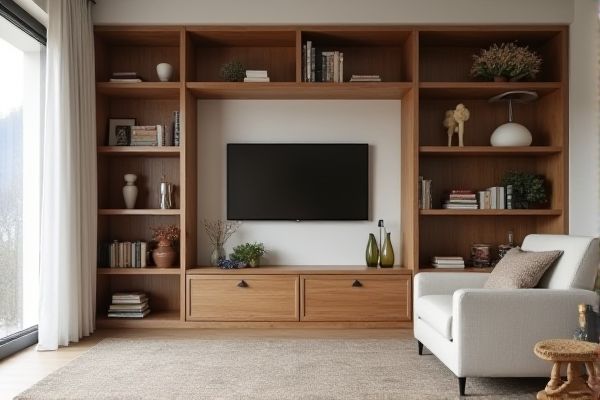
Tall cubbies maximize vertical storage space, ideal for narrow areas or stacking items, while wide cubbies offer broader compartments suited for larger or bulkier belongings. Explore the rest of the article to determine which cubby style best fits your storage needs and preferences.
Table of Comparison
| Feature | Tall Cubby | Wide Cubby |
|---|---|---|
| Dimensions | Height-focused, narrow width | Width-focused, shorter height |
| Storage Capacity | Ideal for taller items like books, binders | Better for wider items like bins, baskets |
| Space Efficiency | Optimizes vertical space | Maximizes horizontal storage |
| Use Case | Small footprint, vertical organization | Larger footprint, horizontal sorting |
| Visual Appearance | Sleek, tall profile | Broader, grounded look |
Introduction to Cubby Storage Solutions
Tall cubbies provide vertical storage space ideal for maximizing rooms with limited floor area, making them perfect for organizing books, shoes, or bins in narrow spaces. Wide cubbies offer broader compartments that accommodate larger items such as baskets, toys, or folded linens, enhancing accessibility and visibility. Both storage solutions optimize organization by tailoring compartment dimensions to specific storage needs, improving overall home or office tidiness.
Tall Cubby vs Wide Cubby: Key Differences
Tall cubbies offer vertical storage ideal for maximizing limited floor space by stacking items, making them suitable for small rooms or offices. Wide cubbies provide broader compartments, allowing for larger or bulkier items to be stored horizontally, enhancing accessibility and visibility of contents. Choosing between tall and wide cubbies depends on space constraints and the types of items to be stored, with tall cubbies optimizing height and wide cubbies optimizing width.
Space Optimization: Which Cubby Maximizes Storage?
Tall cubbies maximize vertical space utilization, making them ideal for storing items like books, files, or tall objects without occupying extensive floor area. Wide cubbies optimize horizontal space, offering broader shelves suitable for larger or bulkier items but requiring more floor footprint. For maximizing storage efficiency in constrained rooms, tall cubbies are often preferable, while wide cubbies suit spacious areas needing larger item accommodation.
Room Suitability: Matching Cubby Shape to Space
Tall cubbies excel in narrow rooms or tight corners where vertical space is abundant but floor area is limited, making them ideal for maximizing storage without crowding your floor. Wide cubbies work best in spacious rooms with ample horizontal space, offering easy access and visibility for items while serving as a functional room divider or display unit. Choosing the right cubby shape depends on your room's layout and available space to ensure efficient use of storage without compromising movement or aesthetics.
Accessibility and Organization Features
Tall cubbies enhance accessibility by providing vertical storage that allows easier retrieval of items without bending, making them ideal for frequently used materials. Wide cubbies offer superior organization through broader compartments, accommodating larger or multiple items side-by-side while maintaining clear visibility. Both designs improve efficiency, with tall cubbies optimizing vertical space and wide cubbies maximizing horizontal layout for categorizing belongings.
Material and Durability Considerations
Tall cubbies typically use reinforced plywood or solid wood to support greater vertical weight, enhancing durability for heavier or stacked storage items. Wide cubbies often incorporate MDF or particleboard with veneer finishes, prioritizing horizontal space but requiring added edge banding to prevent wear and maintain structural integrity. Material choice significantly impacts lifespan; tall cubbies benefit from sturdier, load-bearing substances, while wide cubbies demand durable surface treatments to resist scratches and sagging.
Aesthetic Appeal: Choosing for Your Decor
Tall cubbies create a vertical visual impact ideal for minimizing floor space while drawing the eye upward, enhancing rooms with limited width. Wide cubbies offer a horizontal spread that contributes to a balanced, grounded aesthetic, perfect for larger walls and open spaces. Selecting between tall and wide cubbies depends on room proportions and desired emphasis, aligning storage solutions seamlessly with interior decor styles.
Customization Options and Flexibility
Tall cubbies offer enhanced vertical storage, making them ideal for items like books, binders, and taller equipment, while wide cubbies provide broader horizontal space suited for bulkier or wider objects. Customization options for tall cubbies often include adjustable shelves and modular stacking capabilities, allowing users to maximize vertical space efficiently. Wide cubbies feature flexible divider inserts and varying compartment sizes, enabling tailored organization for diverse storage needs.
Cost Comparison: Tall vs Wide Cubby
Tall cubbies generally cost more due to increased material usage and more complex assembly requirements, while wide cubbies tend to be more budget-friendly because of their simpler design and lower height. Your choice affects not only initial expenditure but also space optimization, as tall cubbies offer vertical storage that maximizes small footprints despite higher costs. Comparing prices from various manufacturers and considering long-term utility will help determine the most cost-effective option for your storage needs.
Final Recommendations: Choosing the Right Cubby for Your Needs
Tall cubbies maximize vertical storage, ideal for small spaces or storing items like books and files efficiently. Wide cubbies provide easier access and accommodate larger items, making them suitable for playrooms or craft areas. Assess your space constraints and usage preferences to select the cubby that best enhances organization and functionality.
 homyna.com
homyna.com